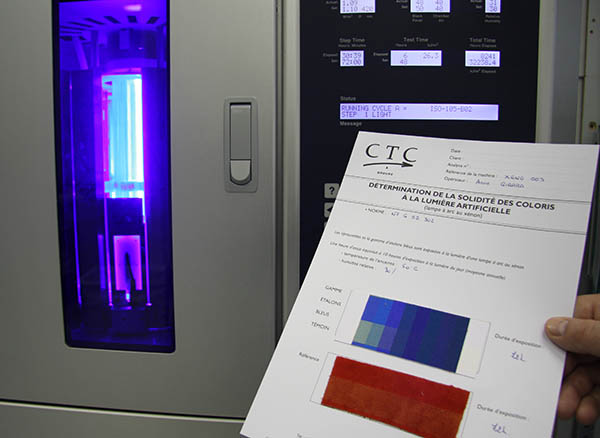

All your products are subject to wear caused by light, washing, rubbing, skin condition, etc. We quantify for you the resistance of your products to these aggressions.
Among the many tests that CTC laboratories can offer, here are three examples of color fastness analysis to characterize your products.
 Colour fastness to perspiration
Colour fastness to perspirationThis test is used to evaluate the staining (transfer) from leather via contact with various types of fabric in the presence of alkaline sweat.
The leather and a standard multi-fibre fabric are immersed in a solution of artificial alkaline sweat, and are then pressed against each other at 37°C for 3 hours; after which, the deterioration and staining run are evaluated against greyscales.
 Fastness cycles of to-and-Fro rubbing on Veslic device
Fastness cycles of to-and-Fro rubbing on Veslic deviceThis test is used to check whether repeated rubbing is able to cause deterioration of the leather colour, on the one hand, and whether the colour can run (transfer) onto the backing material.
The test consists of subjecting a 100 x 25 mm specimen to rubbing (to-and-fro) under constant pressure, with a dry or wet standardised felt pad. The deterioration and staining are then evaluated against greyscales.
 Xenotest or Fastness to artificial light
Xenotest or Fastness to artificial lightThe energy contained in light can cause damage to certain dyes or fibre colors creating discolouration or yellowing of the dyed textiles. To anticipate any colour deterioration that might occur due to light exposure, the Xenotest is the solution.
This test is used to anticipate any colour deterioration that might occur due to exposure to light. It determines the resistance of dyeing under natural daylight on any type of textile or leather. The equipment used to perform the test is called a “Xenotest”, reproducing natural daylight (illuminating D65).

- EN ISO 105 B02 “Textiles -- Tests for colour fastness -- Part B02: Colour fastness to artificial light: Xenon arc fading lamp test”
- Available in ALL CTC Laboratories.
The test consists of subjecting a specimen to the light of a xenon arc lamp (which reproduces daylight more intensely) next to 8 references of dyed blue wool, then used as blue standards to visually assess the colour deterioration of the sample. The colour fastness of the product tested will then be evaluated in comparison to the deterioration of the 8 wool references.
The dyed wool references are identified by a digital designation from 1 to 8. Dyes used in tinting wool have different levels of resistance when it comes to light: a colour noted 1, refers to a very low resistance to light, colours noted 8, have a very high resistance to light.
During the exposure of the textile and wool references tested in the source of light, part of the samples are masked and non-exposed to the light.
In this way, only a portion of the two test-tubes (sample and reference) deteriorates. It is necessary to continue the light exposure of the sample and wool references until contrast between the exposed part and the non-exposed part of the sample tested is equal to a certain deterioration on the grayscale. This deterioration is called "Grade". The exposure time to
light will depend on the selected grade. The exposure time is determined by the grade chosen at the time of carrying out the test, ranks 3 and 4 being the most frequent grates.
Need information or request a quote,
do not hesitate to contact us: